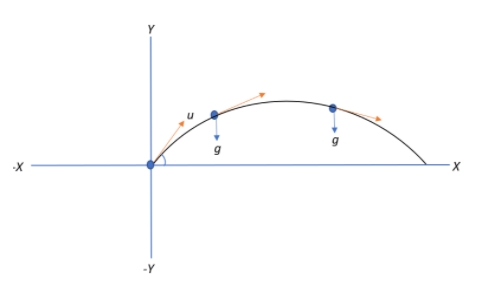
Is the acceleration due to gravity in projectile motion always negative? Explain.
Answer
541.2k+ views
Hint: Recall that a projectile trajectory can be mapped across a suitable coordinate system. The coordinate system that we choose is defined by the coordinate axes that we take. Usually, we take the x-axis to be the horizontal distance and the y-axis to be the vertical position of the projectile. We know that the acceleration due to gravity always acts downwards. Think about which direction (axis) you’d portray this in the abovementioned coordinate system.
Complete answer:
The question basically deals with a case of projectile motion. Projectile motion is a form of motion where an object moves in a parabolic path. It occurs when there is one force that launches the object after which the only influencing force is gravity. The path that the object follows under this influence of gravity is called projectile trajectory. In most cases for our convenience, we neglect air resistance.
Now, consider a projectile launched as shown in the figure. We have charted out the projectile trajectory in a coordinate system, where the x-axis represents the horizontal distance and the y-axis represents the vertical distance travelled by a projectile launched with an initial velocity u. Once the projectile is in the air its motion is guided under the sole influence of gravity. . The coordinate system acts like a fixed reference frame.

We know that the acceleration due to gravity is a vector quantity that is always directed downwards with respect to the projectile. This means that, based on our coordinate system, the acceleration due to gravity is directed along the negative y-axis. And since it is ‘always’ directed downwards irrespective of the position of the projectile, we can say that by convention of the cartesian coordinate system, the acceleration due to gravity is always negative.
Note:
It is important to understand that the acceleration due to gravity might always be negative ‘conventionally’, but it is not necessarily true ‘physically’, if we define the acceleration due to gravity with respect to the ‘motion’ of the projectile. This is because though the acceleration due to gravity always acts downwards, it is in a direction opposite to the motion of the projectile when the projectile is moving upwards, which means that it becomes $-g$ with respect to the projectile trajectory. Similarly, when the projectile starts its descent, the acceleration due to gravity is now in the same direction as the projectile’s motion and hence becomes $+g$. The sign on the acceleration due to gravity is essentially of mathematical significance for evaluating the relevant equations of motion.
Complete answer:
The question basically deals with a case of projectile motion. Projectile motion is a form of motion where an object moves in a parabolic path. It occurs when there is one force that launches the object after which the only influencing force is gravity. The path that the object follows under this influence of gravity is called projectile trajectory. In most cases for our convenience, we neglect air resistance.
Now, consider a projectile launched as shown in the figure. We have charted out the projectile trajectory in a coordinate system, where the x-axis represents the horizontal distance and the y-axis represents the vertical distance travelled by a projectile launched with an initial velocity u. Once the projectile is in the air its motion is guided under the sole influence of gravity. . The coordinate system acts like a fixed reference frame.

We know that the acceleration due to gravity is a vector quantity that is always directed downwards with respect to the projectile. This means that, based on our coordinate system, the acceleration due to gravity is directed along the negative y-axis. And since it is ‘always’ directed downwards irrespective of the position of the projectile, we can say that by convention of the cartesian coordinate system, the acceleration due to gravity is always negative.
Note:
It is important to understand that the acceleration due to gravity might always be negative ‘conventionally’, but it is not necessarily true ‘physically’, if we define the acceleration due to gravity with respect to the ‘motion’ of the projectile. This is because though the acceleration due to gravity always acts downwards, it is in a direction opposite to the motion of the projectile when the projectile is moving upwards, which means that it becomes $-g$ with respect to the projectile trajectory. Similarly, when the projectile starts its descent, the acceleration due to gravity is now in the same direction as the projectile’s motion and hence becomes $+g$. The sign on the acceleration due to gravity is essentially of mathematical significance for evaluating the relevant equations of motion.
Recently Updated Pages
Master Class 11 Economics: Engaging Questions & Answers for Success

Master Class 11 English: Engaging Questions & Answers for Success

Master Class 11 Social Science: Engaging Questions & Answers for Success

Master Class 11 Biology: Engaging Questions & Answers for Success

Class 11 Question and Answer - Your Ultimate Solutions Guide

Master Class 11 Business Studies: Engaging Questions & Answers for Success

Trending doubts
10 examples of friction in our daily life

One Metric ton is equal to kg A 10000 B 1000 C 100 class 11 physics CBSE

Difference Between Prokaryotic Cells and Eukaryotic Cells

1 Quintal is equal to a 110 kg b 10 kg c 100kg d 1000 class 11 physics CBSE

Explain zero factorial class 11 maths CBSE

What is a periderm How does periderm formation take class 11 biology CBSE




